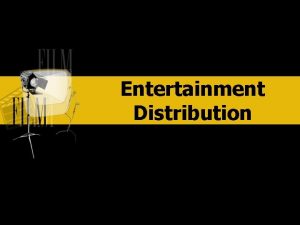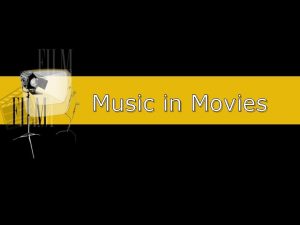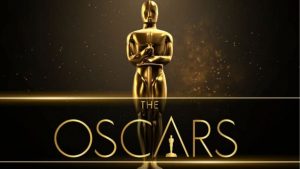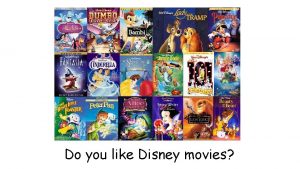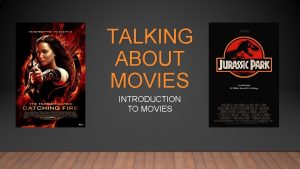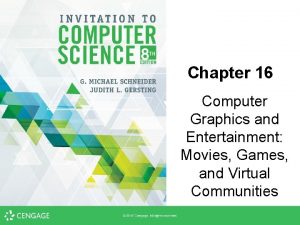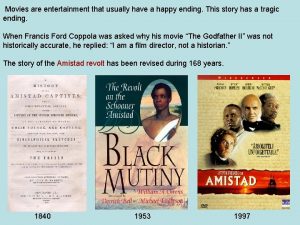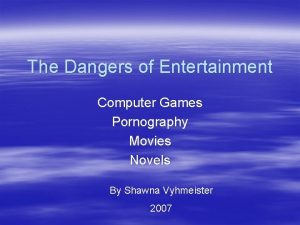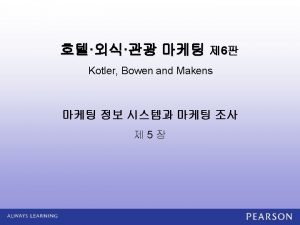8 Movies MassProducing Entertainment The Development of Movies





























- Slides: 29

8 Movies Mass-Producing Entertainment

The Development of Movies • The First Movie Makers § Etienne-Jules Marey: • trained in medicine • wanted to capture movement of blood and heart, and animal movement • developed system for taking repeated photos of people and animals in motion

§ Eadweard Muybridge: • wanted to capture the motion of animals on film • hired to settle a the bet on whether a galloping horse ever had all four hooves off the ground • published Animal Locomotion § Thomas Edison: • kinetoscope—peepshow-like device that played movies • May 9, 1893—made a thirty-second film called “Blacksmith Scene” § Nickelodeons—early screen projection theaters that replaced the kinetoscopes

First Movies • http: //www. youtube. com/watch? v=Yib 9 Jhs. NIQQ&fe ature=player_embedded • http: //memory. loc. gov/cgibin/query/r? ammem/papr: @filreq(@field(NUMBER+ @band(edmp+4030))+@field(COLLID+edison))

§ Auguste-Marie and Louis-Jean Lumiere: • French filmmakers who were brothers • Cinematographe - a portable movie camera that could also be used as a projector • set standards for speed and format of film § http: //www. youtube. com/watch? v=4 nj 0 v. EO 4 Q 6 s § Georges Melies: • A Trip to the Moon • utilized special effects http: //www. youtube. com/watch? v=ZI 9 Oa. ZHxk 64&feature=related

§ Edwin S. Porter: • worked for Edison • The Great Train Robbery (1903) qincorporated twelve separate scenes shot in various locations • began the idea of movie effects § http: //www. youtube. com/watch? v=Bc 7 w. WOm. EGGY

§ D. W. Griffith: • The Birth of a Nation (1915) qran for over three hours, cost more than $110, 000 qcontroversial film about the birth of the Ku Klux Klan o Intolerance qcost nearly $500, 000 qfinancial failure qoutside financial backing became necessary qhttp: //www. youtube. com/watch? v=zkg. SId. OU_cc

• The Studio System § Industry moved from New York and New Jersey to Southern California to take advantage of: • cheap real estate • good weather, diverse shooting locations (ocean, mountains, desert) § Studio System—factory-like way of producing movies, all talent worked directly for the studios § Movie distribution schemes • block booking—bundles of movies that theater owners were forced to purchase, without preview • studios purchased theaters (vertical integration)

• United Artists: § rebellion of popular performers and directors § acquired and distributed independent movies § model for the modern movie studio: • not a maker, but a financer and distributor of films

• Talking Pictures § The Jazz Singer (1927): o silent film with two talking segments o talkie—movie with synchronized sound § Don Juan (1926): o synchronized soundtrack—movie sound that synchronized voices with the pictures § http: //www. youtube. com/watch? v=Xwwuy 2 rsg. Fc

§ Problems with early sound films: • stars had to be able to speak and act at same time • theaters had to upgrade equipment • camera equipment was noisy • picked up set noise

• The End of the Studio System § 1938—U. S. Department of Justice looking into the studios’ monopoly § investigated Paramount Pictures first: • results of investigation: q. Theater owners allowed to preview movies q. Block booking limited to 5 movies § breakup complete in 1948: • Supreme Court forced studios to sell theaters

• The Blacklist § House Un-American Activities Committee (HUAC) (1947) • Investigated communism in Hollywood • Hollywood Ten: qrefused to testify qfound in contempt, jailed, blacklisted • 1953—blacklist contained 324 names

• Television and the Movies § 1946 movie audiences peaked; sales of 80 million tickets per week: • by 1953, 46 million per week § Larger-Than-Life Movies to compete: • bigger and better theaters • 3 -D movies • epics like The Ten Commandments and Spartacus § Television forced movies to convert to color § Growth of multiplexes

The Movie Business • The Blockbuster Era § Jaws (1975): • • • first movie to gross more than $200 million good direction and music score based on a popular novel giant television advertising campaign summer release—coincided with beach and swimming season • http: //www. youtube. com/watch? v=uc. MLFO 6 Ts. FM

• Home Video § 1994—over 85 percent of all U. S. homes had a VCR § 2006— 81 percent had a DVD player, 79 percent had VCRs § The Incredibles —$261 million in theater, $368 million in DVD sales § opened up a world of older movies to today’s audiences

• Going Digital § Star Wars: • George Lucas used a computer-controlled camera to shoot the space battle scenes • Star Wars Episode II—first big-budget feature to be shot entirely using high definition video • http: //www. youtube. com/watch? v=jtnu 4 kc. Kbik&feature =related § technology allows for cheaper production • What Makes a Movie Profitable? § profits based on costs of production and promotion

Movies and Society How Much Influence Do Movies Have? § It Happened One Night: • Sale of undershirts plummet because of Clark Gable scene • http: //www. youtube. com/watch? v=g_Cs. WOx 9 QJs § The Payne Fund: • • series of thirteen studies found repeating themes three-fourths of all movies dealt with crime, sex, or love high level of recall qnovelty and discussion that stimulated recall

• Herbert Blumer § examined how young people thought they had been affected by movies • imitating the behaviors • copying the actions in their games and play • saw movies as a source of ideas about action, romance, and standards of beauty • in essence, learning how to behave as an adult

• The Program: § main character performed extreme stunts § eighteen-year-old boy killed in Pennsylvania, supposedly recreating a dangerous stunt § Touchstone Pictures reacted, as did Janet Reno, then attorney general § investigation determined that young people were doing the stunt years before the release of the movie

• Hurray for Bollywood: India’s Movie Industry § Mumbai, India—produces more than 1, 000 films/year § Masala, or “spice, ” movies • feature several musical numbers, a strong male hero, a coy heroine, and an obvious villain • can have up to ten storylines • have not reached U. S. audiences

• The Production Code: Protecting the Movies from Censorship § Theater owners formed the National Board of Censorship (1909): • establish a national standard for movies • prostitution, childbirth, drug use all on banned list § stars’ off-screen behavior seen as equally offensive • Hollywood viewed as a mass of “wild orgies, ” “dope parties, “kept men, ” and “kept women. ”

• The Birth of the Production Code § set of morality guidelines passed in 1927 § Will H. Hays: • named president of the MPPDA § The Code controlled movie content from the 1930 s until 1968: • • evil not be made to look alluring villains and law breakers not go unpunished no profanity or blasphemy passion needed to be handled carefully

• The Ratings System § Jack Valenti, MPAA President: • scrapped Production Code in 1968 § Ratings assigned by a panel of twelve parents • Screen and discuss three movies a day q. G: General audiences. All ages admitted q. PG: Parental guidance suggested q. PG-13: Parents strongly cautioned q. R: Restricted. Under 17 must be accompanied by adult q. NC-17: No one under age 17 will be admitted

§ Certain content prompts particular ratings: • • drug use requires at least a PG-13 sexually oriented nudity results in an R rough and persistent violence requires an R one use of the “F-word” requires a PG-13 q. If used more than once or in a sexual sense, movies is rated R qhttp: //www. youtube. com/watch? v=KBIdc. Uxdgo 0&NR =1 q. Indiana Jones and the Temple of Doom

• The X Problem: § MPAA did not trademark the X rating. § Porn industry began labeling its unrated films XXX: • if X was adult, XXX would be really adult § Midnight Cowboy: • first and only X-rated movie to win an Oscar for Best Picture • rating eventually changed to R, after award § Saving Private Ryan rating debate • graphic depiction of Normandy landing troublesome to some

The Future of Movies • 2005—U. S. box office down by 6 percent from 2004 § first decline since 1991 § too many sequels and remakes • 1980 s— 50 percent of revenue came from ticket sales § by 1995 fallen below 15 percent • ancillary or secondary markets—movie revenue sources other than the domestic box office § home video, toys, clothes, television rights, product placement, etc.

• Movie Promotion on the Internet § The Blair Witch Project: § sold to Artisan Entertainment for $1. 1 million § low-cost promotion mirrored production style: • mock documentary on cable television • “creepy” website • handlettered posters looked like “missing” posters § garnered $50 million in first week of national release

• Movies and the Long Tail § increased exposure for lesser-known films § digital downloads § ability to get information on non-blockbuster films
 Hát kết hợp bộ gõ cơ thể
Hát kết hợp bộ gõ cơ thể Slidetodoc
Slidetodoc Bổ thể
Bổ thể Tỉ lệ cơ thể trẻ em
Tỉ lệ cơ thể trẻ em Voi kéo gỗ như thế nào
Voi kéo gỗ như thế nào Glasgow thang điểm
Glasgow thang điểm Hát lên người ơi alleluia
Hát lên người ơi alleluia Môn thể thao bắt đầu bằng chữ f
Môn thể thao bắt đầu bằng chữ f Thế nào là hệ số cao nhất
Thế nào là hệ số cao nhất Các châu lục và đại dương trên thế giới
Các châu lục và đại dương trên thế giới Công thức tính độ biến thiên đông lượng
Công thức tính độ biến thiên đông lượng Trời xanh đây là của chúng ta thể thơ
Trời xanh đây là của chúng ta thể thơ Mật thư anh em như thể tay chân
Mật thư anh em như thể tay chân 101012 bằng
101012 bằng độ dài liên kết
độ dài liên kết Các châu lục và đại dương trên thế giới
Các châu lục và đại dương trên thế giới Thể thơ truyền thống
Thể thơ truyền thống Quá trình desamine hóa có thể tạo ra
Quá trình desamine hóa có thể tạo ra Một số thể thơ truyền thống
Một số thể thơ truyền thống Cái miệng xinh xinh thế chỉ nói điều hay thôi
Cái miệng xinh xinh thế chỉ nói điều hay thôi Vẽ hình chiếu vuông góc của vật thể sau
Vẽ hình chiếu vuông góc của vật thể sau Nguyên nhân của sự mỏi cơ sinh 8
Nguyên nhân của sự mỏi cơ sinh 8 đặc điểm cơ thể của người tối cổ
đặc điểm cơ thể của người tối cổ Thế nào là giọng cùng tên
Thế nào là giọng cùng tên Vẽ hình chiếu đứng bằng cạnh của vật thể
Vẽ hình chiếu đứng bằng cạnh của vật thể Vẽ hình chiếu vuông góc của vật thể sau
Vẽ hình chiếu vuông góc của vật thể sau Thẻ vin
Thẻ vin đại từ thay thế
đại từ thay thế điện thế nghỉ
điện thế nghỉ Tư thế ngồi viết
Tư thế ngồi viết






























